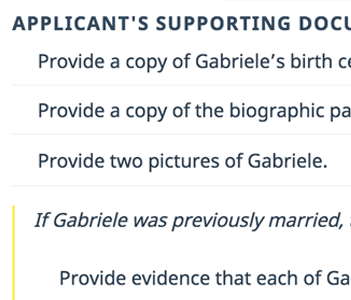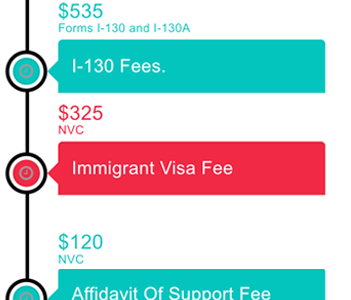Filing Your Green Card Application
Key elements about forms and supporting documents to get your family green card application accepted and processed by USCIS or the NVC.
Start your application
Green Card Forms
Forms: Which are needed?
Petition
Family immigration starts with Form I-130. It is is called a ‘petition’, because it is filed by persons requesting an immigration benefit (the Green Card) for a foreign relative: the family sponsor (the ‘petitioner’) is filing on behalf of the applicant (the ‘beneficiary).
The primary purpose of Form I-130 is to establish that the family relationship between applicant and sponsor is ‘qualifying’ for the purposes of U.S. immigration.
Learn More
Green Card application
The actual Green Card application is filed by applicants themselves either concurrently with Form I-130 (adjustment of status with concurrent filing for immediate relatives of U.S. Citizens), or for all other applicants once Form I-130 has been approved.
The exact form depends on the process: adjustment of status applicants submit a paper Form I-485 to USCIS, while applicants going through consular processing submit an online DS-260 to the National Visa Center (NVC).
The focus is on applicants: is there anything about their past and present circumstances that would make them ineligible for a family Green Card?
Affidavit of Support
The family sponsor is making a formal and binding commitment to support the applicant financially, if the applicant was in a situation where they were not earning enough money on their own and needed such support. Family sponsors need to either show that they meet the minimum income requirements (which is derived from the size of their household), or find a joint-sponsor (there other paths, but these two are most common).
Family sponsors file Form I-864 (whether or not they have a joint-sponsor), and joint-sponsors (if any) also file Form I-864. Some family sponsors are able to file a simplified (and less confusing) affidavit of support form called Form I-864EZ.
Medical Exam
The medical exam of the applicant is performed by an authorized doctor either in the United States (adjustment applicants –> Form I-693), or in the country where the interview will take place (consular applicants).
The medical exam need to take place near the time of the interview because it is valid for 2 years in adjustment cases (and the wait for an I-485 interview at USCIS Field offices might be longer) and only 6 months in consular cases (how long the temporary Green Card visa in the applicant’s passport is valid is determined by the validity of the medical exam).
Adjustment applicants also file for employment authorization while they wait for their interview and Green Card (Form I-765) and advance parole (Form I-131), which allows applicants to travel in and out of the United States without abandoning their adjustment application.
Some consular applicants need ‘waivers’ to overcome bars (such as the 3-year or 10-year bar) or inadmissibility grounds.
Applicants who are spouses of U.S. Citizens or Green Card holders need also file Form I-130A.
Finally, all applicants and sponsors generally file Form G-1145 to receive electronic (text or email) notifications about their cases.
Forms: Key success factors?
The application needs to be first ‘accepted’ before it can be processed. For most applicants, this means getting at some point through USCIS ‘intake’ process. We focus here on the most frequent reasons why paper applications are rejected. If you want to go deeper at some point, you can read ‘Form Filing Tips‘ directly from USCIS.
Complete
All questions need to be answered either directly, or through ‘N/A’ (not applicable to the applicant’s circumstances) or ‘NONE’, especially for paper-based forms.
Signed
Properly signed. This might be reason number 1 applications are rejected: either the family sponsor (I-130, I-864), or the applicant (I-485, I-130A), or the joint-sponsor (I-864) did not properly sign a form.
With Fees
It needs to be exactly the right amount (some adjustment applicants forget the biometric fee) provided through an acceptable means of payment.
Latest Form Version
Immigration forms change, and USCIS will only accept the current version of the form (and might grant a grace period of about 60-days to file with the older version). The current version is the one that is on USCIS website.
Do not pay attention to the ‘Expiration’ in the top right corner, only double-check that the ‘Edition’ date in the bottom left corner is the same as the form you are about to send.
Showing Eligibility
Check on the apparent eligibility of the applicant to file Form I-485 is a key part of the intake process:
- Applicants who file for adjustment ‘concurrently’, but filed the I-130 online to provide a receipt of that submission along with their I-485;
- Applicants for adjustments under a ‘preference’ category need to provide an I-797 (approval of I-130) and need to have a Priority Date that is ‘current’ when compared with the ‘Filing Date’ of the Visa Bulletin (when using Filing Dates is allowed).
Consistent Answers
Identifying answers- name (first, middle, last), date of birth, and A-Number (if any) need to be entered exactly the same way across all forms.
On Form I-130, be aware that the answer to the question ‘the beneficiary will apply for adjustment of status’, or ‘the beneficiary will apply for an immigrant visa abroad’ determines the Green Card process (not the applicant’s current physical address). So answer only one of these questions, and the one that corresponds to the applicant proces.
Key Goals

Applicable forms must be 100% complete, valid, consistent, logical, and showing eligibility.

Supporting documents must be adequate, issued by the appropriate authority, and in English or translated.

The correct amount must be paid with an appropriate payment method.
Supporting Documents
Supporting Documents: What to submit?
Before we give an overview of the various documents that are needed, let’s start with some documents that every Green Card application must contain:
- Evidence of the U.S. legal status of the sponsor (either as a U.S. Citizen, or as a Green Card holder);
- Biographic page of the (principal and derivative) applicant(s)’ passport;
- Passport style pictures of the applicant;
- Only for spouse cases, passport style pictures of the sponsor (for the I-130);
- Birth certificate of the applicant (principal and derivative);
- Certified police and court records of criminal charges, arrests, or convictions.
The one and only source for evidence is the list of “Reciprocity and Civil Documents by Country“ that is maintained by the U.S. Department and used as a reference by both the National Visa Center (NVC) and USCIS. For all the evidence supporting a Green Card application (such as birth & marriage & divorce & police certificates, military records, …), the list provides:
- Whether the document is considered ‘available’ or not (if ‘available’, then it needs to be submitted;
- Who is the appropriate ‘Issuing Authority’;
- Procedure for obtaining;
- Alternate Documents;
- …
Qualifying Relationship
Evidence establishing that the family relationship between applicants and sponsors meets U.S. Immigration Agencies criteria is needed at all stages of the Green Card process. What to submit depends on the family relationship (spousal, sibling, parent / child) and how it was established. There are too many scenarios, and Immigration Planner’s web application does a great job at providing a personalized list based on the circumstances, so let us simply highlight a few things:
- It is up to applicants and sponsors to prove that the family relationship exists (not up to USCIS or the NVC to ‘disprove’ its existence;
- For certain relationships, you first need to prove that the family relationship exists ‘technically’ (for example, a legal marriage took place), before you prove it is real (for example, the marriage was not entered into solely for the purposes of U.S. immigration);
- Parent / Child relationships have different rules depending if it is a biological relationship, a step-parent / step-child relationship, or an adoption relationship;
- Any parent / child relationship usually needs ‘long-form’ certificates so that the full name of the parents and child are listed;
- Siblings need to demonstrate that they share at least one common parent;
- It is usually easier to demonstrate a mother / child relationship than a father / child relationship;
- When there is any marriage in the demonstration (obviously for a spousal case, but also for step-parents or step-children cases), then the fact that the marriage was entered by people who were ‘free-to-marry’ needs to be established (which means that all prior marriages were legally terminated through divorce, or death).
Bona Fide Marriage
Essentially a marriage entered in ‘good faith’, that is one that was not entered into for the sole purpose of the applicant (‘beneficiary’) getting a Green Card (even if this can be one of the reasons). What is important here is that U.S. Immigration agencies have different expectations for people who just got married than for people who have been married for a few years.
In other words, spend time after the I-130 to document your marriage and how it gradually affects more and more aspects of your life. The Consular Officer will expect more than the NVC, which expects more than at the time of the I-130 submission. USCIS expects more at the I-485 Interview than they did when they adjudicated the Employment Authorization.
That being said, the traditional ‘buckets’ are:
- Children together;
- Living together (as proven by utility bills, leases, …);
- Co-mingling of finances (joint property, active joint bank accounts, filing U.S. taxes together, …);
- Sharing insurance such as health insurance, car insurance, or having the spouse as beneficiary of a meaningful life insurance.
You are allowed to be creative, and go to your day-to-day life to find evidence, such as travel together (documented by travel tickets), cell phone family plan, joint membership at the movies / gym / …
Needless to say that Social Media type conversations are helpful. All applicants know that.
It is always more challenging to make a case when the marriage is young and the spouses are living apart. It just is.
Immigration History
For applicants going through adjustment of status, special attention is paid to their U.S. immigration history, in particular:
- For all applicants, evidence of legal entry into the United States because applicants who are EWI (Entry Without Inspection) cannot file for adjustment. Most applicants can retrieve an I-94 online through the Custom and Border Patrol website (CBP);
- For applicants under a ‘preference’ (F1, F2A, F2B, F3, F4) classification, evidence that the applicant is currently ‘in-status’, and has been since they last entered the United States (only immediate relatives can file Form I-485 while being under an expired U.S. visa).
Some evidence might also be provided with an eye towards preemptively overcoming the 90-day rule.
Note that applicants going through consular processing do not need to provide this documentation.
Civil Documents
For applicants going through consular processing, an emphasis has to be put on two of the most painful documents to obtain from the NVC list: police certificates and military records.
Applicants need to provide police certificates for every country where they lived for more than 12 months since they turned 16 (and only 6 months for both their country of nationality and current residence).
Police certificates are valid only two years, so many applicants (especially in these Covid-19 times) need to bring a new, updated, police certificate to their interview (at least for their country of current residence).
Note that this evidence request does not apply to applicants going through adjustment of status.